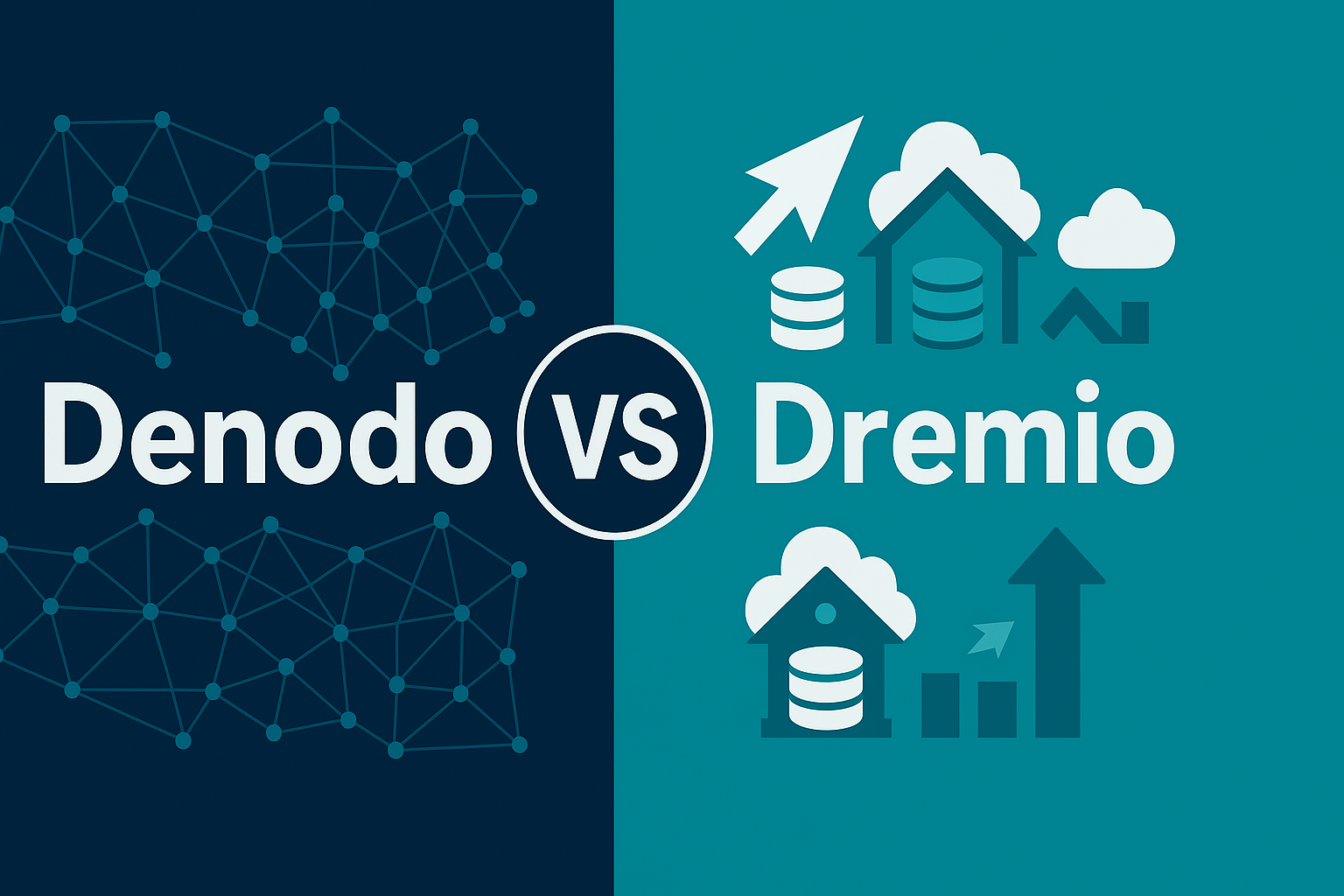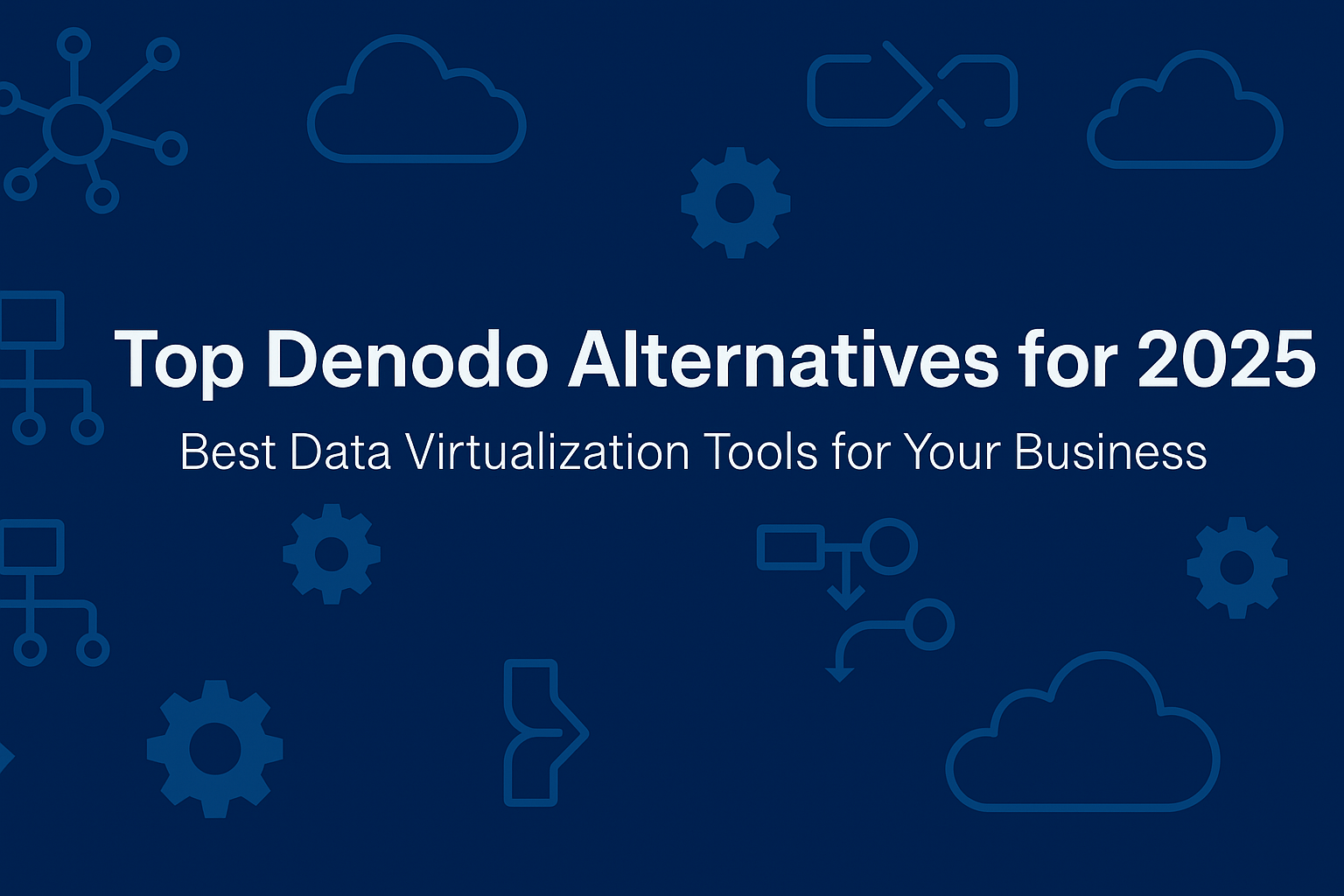Denodo vs Dremio: Which Data Virtualization Tool is Right for You?
Optimize Your Data Integration Success
Choosing the right data platform can make all the difference in your organization’s analytics success. The “denodo vs dremio” comparison represents more than just a technology choice—it’s about aligning your entire data architecture with your business objectives.
Both platforms offer unique advantages for modern data strategies, but they take fundamentally different approaches to solving data challenges. This comprehensive guide will help you decide which platform is the best fit for your specific situation.
What Makes These Data Platforms Unique?
Denodo – Data Virtualization Excellence

Denodo, founded in 1999, pioneered data virtualization technology that gives you complete control over data integration across multiple sources. This makes it the perfect choice for organizations who need a unified view of their data without moving it. Verification successful waiting for your data doesn’t have to involve complex ETL processes—Denodo creates a logical data layer that abstracts the complexity of your underlying systems. Additionally, Denodo provides a visual ETL interface, data modeling tools, and pipeline automation capabilities for seamless data integration.
Key benefits of Denodo:
-
Broad data source connectivity
-
Real-time data access
-
Unified security layer
-
Comprehensive data governance
Denodo’s approach to democratizing data access focuses on creating a virtual layer that unifies disparate data sources without physical data movement. This virtualization technology makes it ideal for organizations with complex, heterogeneous data landscapes, especially those operating in highly regulated industries where data movement is restricted.
Dremio – Native Lakehouse Architecture

Leveraging Apache Arrow and cloud-native capabilities, Dremio offers high-performance analytics directly on your data lake. Founded in 2015, Dremio operates beautifully in big data environments, giving you robust, accelerated queries without complex ETL. Verify you are human by completing the data integration with Dremio, and you’ll experience a modern approach to analytics that eliminates traditional data warehouses in favor of direct access to your data lake. Dremio is primarily designed for deployment in cloud environments like AWS, Azure, and Kubernetes, making it a natural fit for organizations embracing cloud-first strategies.
Key benefits of Dremio:
-
High-performance query acceleration
-
Direct access to data lake sources
-
Self-service semantic layer
-
Cloud-optimized architecture
Dremio’s “reflections” technology—materialized, columnar data structures—dramatically accelerates query performance without duplicating data. This architecture enables sub-second response times even on massive datasets, making it exceptionally well-suited for organizations operating at petabyte scale. Dremio primarily focuses on query acceleration for big data workloads, ensuring that even the most complex queries are executed efficiently.
Denodo vs Dremio: What’s the Difference?

Integration Approach
-
Denodo: Complete virtualization across diverse data sources, connecting to virtually any system—from traditional databases to SaaS applications. Human by completing the action of configuring Denodo means you can integrate data from relational databases, NoSQL stores, cloud applications, and even flat files without physically moving the data.
-
Dremio: Native optimization for big data and cloud storage, with particular strength in analyzing data already consolidated in corporate lakehouses or object storage. Dremio excels when working with massive datasets stored in cloud platforms like AWS S3, Azure Data Lake, or Google Cloud Storage.
The ray id of your data integration approach will differ significantly depending on your choice. Denodo’s virtualization layer works best when data must remain in its original locations, while Dremio shines when you’re building around a central data lake strategy.
Performance
-
Denodo: Optimized for real-time access and federation, with smart caching and query delegation to source systems. Performance security depends heavily on the capabilities of underlying systems and the complexity of virtual views.
-
Dremio: Designed for high-speed analytical workloads with vectorized execution and columnar storage optimization. Dremio’s use of Apache Arrow enables exceptionally fast processing, particularly for interactive analytics and data exploration. Additionally, Dremio helps significantly reduce infrastructure costs compared to traditional data warehouses, making it a cost-effective choice for modern analytics.
The security of your connection before proceeding with either platform is crucial, but their performance characteristics differ dramatically based on workload types. Denodo excels at diverse query patterns across heterogeneous sources, while Dremio delivers exceptional speed for analytical workloads on large datasets.
Use Cases
-
Denodo: Enterprise data fabric and hybrid environment integration scenarios. Denodo is particularly well-suited for:
-
Building unified customer or product views across siloed systems
-
Providing real-time dashboards with data from various sources
-
Supporting regulatory compliance with tight governance
-
Master data management across disparate systems
-
-
Dremio: Data lakehouse and cloud data analytics. Dremio excels at:
-
Interactive analytics for data scientists directly on lake data
-
Self-service BI and exploration for massive datasets
-
Accelerating time-to-insight for cloud-native organizations
-
Eliminating ETL bottlenecks in data pipelines
-
Both platforms can deliver effective data democratization, but Denodo provides more comprehensive control for complex integration scenarios, while Dremio offers superior performance for analytical workloads.
What Experienced Users Say
Denodo Enthusiasts Love:
- Seamless integration with existing systems
- Protection from data movement complexity
- Unified governance potential
Dremio Users Love:
- Direct-to-source query patterns
- Lower data engineering needs
- Dramatic performance improvements
Technical Requirements Overview
-
Denodo Platform: Regular attention to metadata management, caching strategies, and security controls. The platform needs to review the security of all connected systems and requires careful configuration to balance performance with data freshness requirements.
-
Dremio Platform: Reflection management with cloud storage optimization. Organizations should optimize for data partitioning, file formats (Parquet, ORC), and configure role-based access controls to protect sensitive data.
Both require well-designed data architectures and proper security configurations. Organizations must plan for network throughput, user concurrency, and compliance requirements specific to their industries. Companies deploying either platform should consider their existing technical debt and skill sets—Denodo typically demands more integration expertise, while Dremio requires data lake optimization knowledge.
Comparative Analysis
|
Feature |
Denodo |
Dremio |
|---|---|---|
|
Core Technology |
Data Virtualization |
Native Lakehouse/Lake Query Engine |
|
Primary Deployment |
On-premises, cloud, hybrid |
Cloud-native, Kubernetes, hybrid |
|
Data Sources |
Very broad (DB, SaaS, NoSQL, files) |
Cloud data lakes, DBs, some SaaS |
|
Query Performance |
Good, source/caching dependent |
Sub-second, very high on lakes |
|
Data Movement |
None (logical integration) |
Minimal to none (in-place analytics) |
|
Data Governance |
Deep, fine-grained, lineage, masking |
Good, less extensive than Denodo |
|
Popular Use Cases |
Data Fabric, MDM, compliance |
Self-service, BI/analytics, science |
|
Technical Complexity |
High (initial setup/governance) |
Moderate (reflection tuning) |
Analysts reviewing both platforms consistently highlight that completing the action of selecting the right platform requires evaluating your organization’s specific requirements rather than focusing solely on technical capabilities.
Which Data Platform is Right for You?
Choose Denodo if you want:
✔ Total control over diverse data sources
✔ Real-time data access capabilities
✔ Enterprise-wide data virtualization
✔ Stringent governance and compliance features
✔ Minimal data movement
Denodo is ideal for organizations with complex, distributed data landscapes spanning multiple technologies, particularly those in highly regulated industries where data movement is restricted or where data sovereignty is a priority. Denodo also provides a large and active community of users along with comprehensive technical support, making it a reliable choice for enterprises.
Choose Dremio if you want:
✔ High-performance analytical queries
✔ Direct data lake access
✔ Large-scale cloud data processing
✔ Self-service analytics capabilities
✔ Reduced ETL complexity
Dremio shines for organizations seeking to modernize their analytics around a data lake strategy, especially those prioritizing analyst self-service and interactive performance on large datasets. Additionally, Dremio consistently emerges as the superior choice for businesses looking to gain a competitive advantage through data-driven decision-making.
Implementation Considerations
When implementing either platform, it’s crucial to proceed with a well-defined strategy. The needs to review existing data sources, security requirements, and performance expectations should be addressed early in the planning process. Denodo typically requires more technical expertise to set up and manage, making it less accessible to the broader workforce, while Dremio’s focus on self-service analytics can be more user-friendly for non-technical teams. While Dremio has a smaller community compared to Denodo, it provides good support through documentation and customer support channels.
For Denodo deployments, focus on:
-
Comprehensive data source cataloging
-
Metadata management strategy
-
Caching policies aligned with data freshness needs
-
Security integration with existing authentication systems
For Dremio implementations, prioritize:
-
Data lake organization and partitioning
-
Reflection design for key workloads
-
Cloud storage optimization
-
Self-service enablement for business users
Both platforms can work effectively in hybrid environments, but organizations should carefully evaluate their existing infrastructure and skill sets before making a final decision. The terms of your implementation should include clear performance benchmarks and governance guidelines.
Future-Proofing Your Decision
As data ecosystems continue to evolve, both Denodo and Dremio are adapting to emerging trends. Denodo is expanding its cloud capabilities and enhancing its semantic layer, while Dremio continues to improve its performance and self-service features.
When evaluating these platforms, consider not just your current needs but where your data strategy is headed. Organizations increasingly want to manage and create insights from diverse data sources while maintaining compliance and security—both platforms address these needs, albeit through different approaches.
The verification successful message you want to see after implementation should reflect your organization’s specific goals:
-
Reduced time-to-insight for business users
-
Improved data governance and compliance
-
Enhanced analytical capabilities
-
Streamlined data operations
Factory Thread – Purpose-Built Virtualization for Smart Manufacturing
While Denodo and Dremio serve broad enterprise and analytics use cases, Factory Thread is engineered specifically for the manufacturing sector—where real-time data, system diversity, and edge-to-cloud orchestration are mission-critical. It creates a logical data layer across ERP, MES, SQL, APIs, and even flat files, enabling decision-makers to access and act on unified data without replication.
Key benefits of Factory Thread:
-
True Real-Time Federation: Access live data from disparate systems without ETL or duplication.
-
No-Code/Low-Code Workflows: Visual interface with AI-powered suggestions accelerates integration setup.
-
Built for Industrial Systems: Connectors for Siemens Opcenter, Rockwell Plex, SQL, REST APIs, and more.
-
Hybrid Deployment: Deploy workflows in the cloud or on-prem with edge runtimes and zero downtime.
-
Self-Service Data Catalog: Empower teams to discover, trust, and query data without needing SQL skills.
Factory Thread is ideal for:
✔ Operational intelligence and KPI tracking
✔ Manufacturing data unification and automation
✔ Real-time scheduling and inventory monitoring
✔ Bridging legacy systems with modern analytics
✔ Scalable, secure deployments across plants and cloud
Why Choose Factory Thread?
Factory Thread fills a critical gap that Denodo and Dremio don't directly address—it unifies operational and business systems specifically for manufacturers, making it easy to automate dataflows, surface real-time insights, and manage compliance without deep IT involvement. It also scales from plant-level deployments to enterprise-wide rollouts, making it a future-proof choice for growing operations.
Factory Thread isn't just another data virtualization tool—it's a manufacturing data platform purpose-built to make operations smarter, faster, and more agile.
Share this
You May Also Like
These Related Stories

Denodo vs Tableau: A Comparative Analysis of Data Visualization Tools

Alternatives to Denodo’s Data Virtualization Platform (for 2025)
.png)


No Comments Yet
Let us know what you think